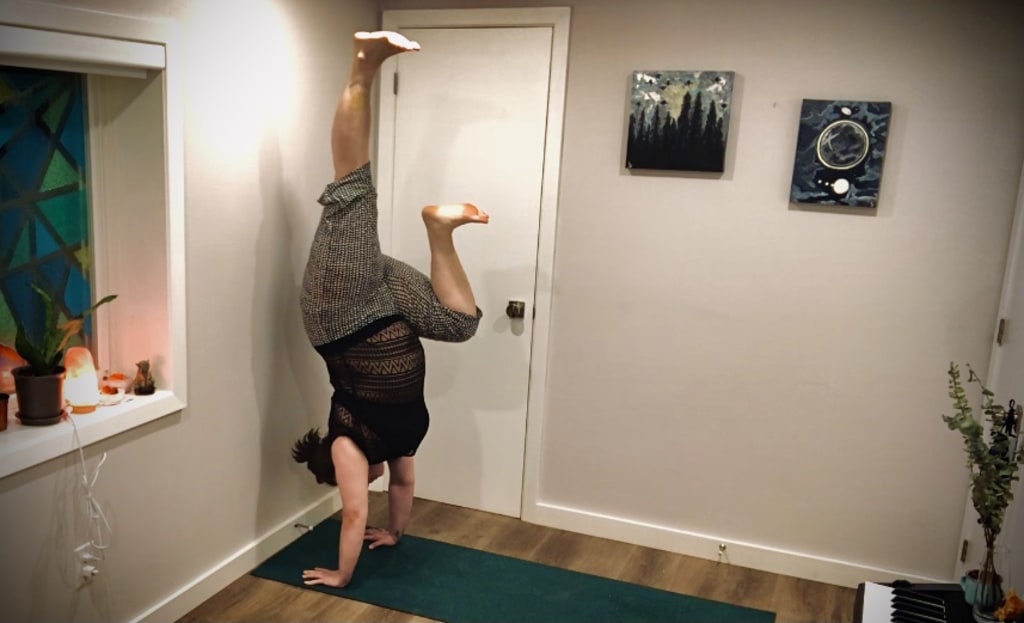Moving My Big Body and How You Can Move Joyfully
By: LJ Livingston

Looking at yoga and movement hashtags on social media, you’re sure to find lots of different body types, but you’ll see the most representation for thin and petit bodies. My body has changed a lot through the last 12 years of my yoga practice, but my body has never fit into the classic Lululemon aesthetic that fills the pages of Instagram. Even when I was strictly dieting and working out vigorously for hours a day, my body was curvaceous and supple. Through injury and mental illness, my body has grown larger to protect me, and for that, I am so thankful.
What I’m interested in exploring is how the fat on my body has changed the way in which I move. If I’d been writing this 6 months ago, I might have said something like, “Additional weight and fat makes movement more challenging.” But, I’ve had lots of time to explore my fat body, and that is a fake narrative perpetuated by diet and weight-loss culture.
As I mentioned earlier, there isn’t a lot of representation in the fitness and yoga space for large bodies, and because of that, many fitness and yoga teachers don’t really know how to teach to varying body types. People like Jessamyn Stanley (@theunderbellyyoga), Christina Wherry (@thickgirlyogala), Shannon Kaneshige (@fringeish), and Reyna Cohan (@reynisima) are all doing some powerful and beautiful work to show how we can move and love our bodies. You can find all of them on social media, and if you’re looking for ways to create joy through movement, I highly recommend following all of them!
As my body grew larger to accommodate its needs after an injury I experienced at the beginning of 2020, I started to notice feelings of shame and fear of judgment. My inability to move turned into a fear of movement. I fell into the belief that I couldn’t move in certain ways because of the extra weight. It took a few months of inviting gentle movement and compassionate exploration into my body to start to feel a little more comfortable. I’ve been teaching mindfulness-based movement for 6 years, and I have a wealth of movement knowledge at my fingertips. What I realized is that it is the feeling of shame around what our bodies look like that makes moving challenging, not the shape or the weight of our bodies. My body is strong and wise and beautiful. There is no reason based in reality that I can’t move freely in a fat body. There is no reason based in reality that I should have to change my body in order to experience joyful and expressive movement.
Lack of mobility only furthers lack of mobility, so naturally, when we are shamed out of moving, we lose mobility. That, along with the societal norms of what “healthy movement” is supposed to look like, is what makes moving in a big body challenging. Regardless of the body you exist in, if you are told constantly that you can’t move the “right way,” it is going to be harder to move. So, how do we learn to move our bodies when we're constantly bombarded with toxic messages about what our bodies shouldn't do?
Acknowledging that your body today is not better or worse than any other version of your body is step one. My body is different than it was a year ago, and if my goal is loving and joyful movement, one of the best gifts I can offer myself is to create movement for the body I am in right now. Not the one I was in during my early 20s when I was biking 10 miles a day, not the one I was in three years ago when I was injury-free and studying Kung Fu, and not some idealized future me who has Wonder Woman strength. This is also a helpful reminder for the day-to-day fluctuations of our weight, strength, hormones, and energy levels. Every time I step on my mat or head outside for a walk, I self-assess. How am I feeling in this moment? What do I have the energy, time, and space for today? How can I express love to myself right now?
This brings me to step two: invite variety into your movement practices. Yoga is, and will likely always be, my favorite form of movement. I love that I can be slow and intentional while focusing on breathing and creating expressive shapes with my body. As one of my teachers, Diane Bruni, often said, “versatility in movement is the key to longevity in the body.” What an incredible and freeing thought. There are so many methods of movement, and opening ourselves to all the possibilities can be a joyful and fulfilling process. I have studied many varying movement modalities including Ashtanga, Hatha, Kundalini, Aerial, Yin, and Restorative Yoga; Kung Fu and Capoeira; Ballet, Jazz, and Contemporary dance; indoor and outdoor cycling; Fighting Monkey, Hanna Somatics, Axis Syllabus, DNS, and so many more. Incorporating varying movement practices not only allows our bodies that variety we need to stay agile and mobile for the long term, but it’s also fun and exciting! When I go to move my body, I’m not limited to one modality, I have lots to choose from, and I can pull little bits from each practice to create something that feels fulfilling for whatever my body is craving in the moment. Know that you don’t have to be anything to try something. You don’t have to be a dancer to dance, or a fighter to study MMA, or a runner to run. If you simply trust yourself, you are exactly what you need to be right now to move in whatever way feels most joyful and beneficial.
That’s step three: trust your intuition. Intuition is my word of the year, and the intention I’ve set for myself. As a survivor of abuse, learning to trust myself and get to know my inner voice has been a difficult journey, but it’s also been the most rewarding thing I’ve ever done for myself. One reason it’s so challenging is because of all the external noise we’re all bombarded with every day, and listening to and believing that noise instead of listening to our inner voice is what makes moving in a big body challenging. At the core of each of us, we know what we need. We know when we need to move our bodies and how, just like we know when we’re hungry and what foods would be most nourishing. The overwhelming external noise that people with fat on their bodies hear about how to move and what to eat, along with the false command that we must move and eat and look a certain way to be valuable is as toxic as it is intoxicating. We become so addicted to the validation of others that we forget our ability to validate ourselves. We forget that no one knows our bodies like we do. I reattuned myself to my intuition by sitting alone with and learning myself. Through mindful movement, I learned how to move my body, and through gentle touch, I refamiliarized myself with who I am and what my body needs.
Regardless of your body type, I am sure you’ve heard an instruction in a movement practice that you knew was totally impossible in your body. If you’re like me, it’s possible that cue made you feel a little helpless. Like, what’s the point of even trying if the movement you’re instructed to do is unattainable. The problem is not your body or your ability, but the instruction that was only ever meant for a body that doesn’t look like or move like your body. That doesn’t mean you need to change your body, it means we need to change the instruction. Let’s take the yoga pose shoulder stand as an example. The cue you’ll hear a lot of yoga teachers give is “stack your heels on top of your hips, hips on top of your shoulders."

The goal with this instruction is to make a straight line with your body. If you have a belly, large breasts, and/or a big booty, this cue is literally impossible to attain. So you’re made to think that you can’t do shoulder stand, possibly feeling that you’re inadequate and need to change your body in order to do the pose. This couldn’t be further from the truth! You absolutely can do shoulder stand, it’s just not going to look the same in every body, and that is not only okay, it’s freaking beautiful!

The goal of shoulder stand is to lift your hips above your heart. The engagement is meant to be felt in your low belly and inner thighs. That is going to look dramatically different from one body to the next, but when our focus is on a task rather than an aesthetic, we can experience the fullness and majesty of our strength and mobility.
Through accepting and loving the body you’re in right now, learning about various movement modalities and creating a versatile and joyful movement practice that suits you, creating an intimate relationship with your body to learn its needs, and trusting your intuition we can all move joyfully. I have done a handstand in a thin body and I have done a handstand in a fat body. Lifting more weight into a handstand takes more strength, and I can celebrate how much stronger I am now, but doing a handstand is always fun at any size. There is no reason we can’t all enjoy moving our bodies. Release external noise, return to your Self, and move freely. You are allowed, your body is wise, and you are worthy just as you are right now.
(If you'd like to move joyfully with me, I offer two free virtual classes per week. Find more info at ym4s.com and @ym4survivors on Instagram. YM4S was created for survivors of abuse, but all are welcome, safe, and loved.)






Comments
There are no comments for this story
Be the first to respond and start the conversation.